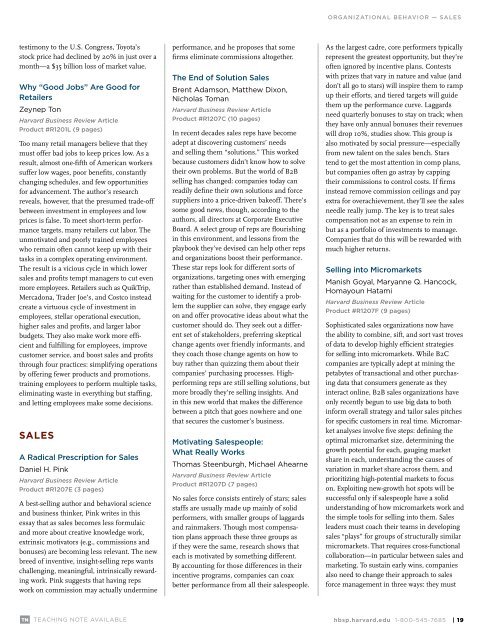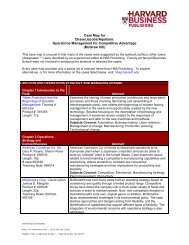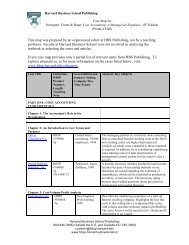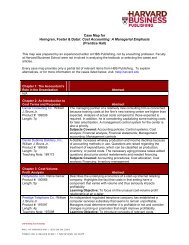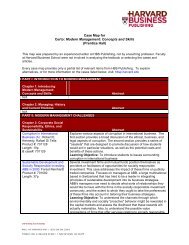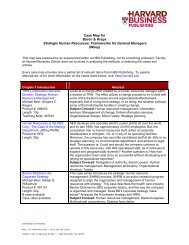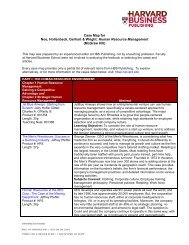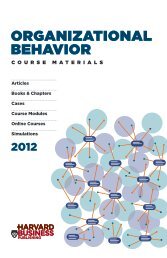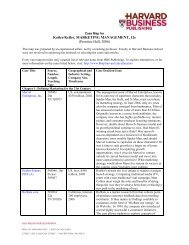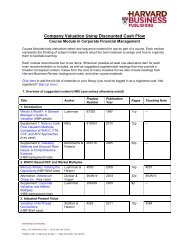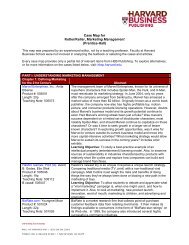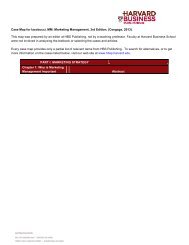teAcHing MATErIAlS - Harvard Business School Press
teAcHing MATErIAlS - Harvard Business School Press
teAcHing MATErIAlS - Harvard Business School Press
Create successful ePaper yourself
Turn your PDF publications into a flip-book with our unique Google optimized e-Paper software.
testimony to the U.S. Congress, Toyota’s<br />
stock price had declined by 20% in just over a<br />
month—a $35 billion loss of market value.<br />
Why “Good Jobs” Are Good for<br />
Retailers<br />
Zeynep Ton<br />
<strong>Harvard</strong> <strong>Business</strong> Review Article<br />
Product #R1201L (9 pages)<br />
Too many retail managers believe that they<br />
must offer bad jobs to keep prices low. As a<br />
result, almost one-fifth of American workers<br />
suffer low wages, poor benefits, constantly<br />
changing schedules, and few opportunities<br />
for advancement. The author’s research<br />
reveals, however, that the presumed trade-off<br />
between investment in employees and low<br />
prices is false. To meet short-term performance<br />
targets, many retailers cut labor. The<br />
unmotivated and poorly trained employees<br />
who remain often cannot keep up with their<br />
tasks in a complex operating environment.<br />
The result is a vicious cycle in which lower<br />
sales and profits tempt managers to cut even<br />
more employees. Retailers such as QuikTrip,<br />
Mercadona, Trader Joe’s, and Costco instead<br />
create a virtuous cycle of investment in<br />
employees, stellar operational execution,<br />
higher sales and profits, and larger labor<br />
budgets. They also make work more efficient<br />
and fulfilling for employees, improve<br />
customer service, and boost sales and profits<br />
through four practices: simplifying operations<br />
by offering fewer products and promotions,<br />
training employees to perform multiple tasks,<br />
eliminating waste in everything but staffing,<br />
and letting employees make some decisions.<br />
sAles<br />
A Radical Prescription for Sales<br />
Daniel h. Pink<br />
<strong>Harvard</strong> <strong>Business</strong> Review Article<br />
Product #R1207E (3 pages)<br />
A best-selling author and behavioral science<br />
and business thinker, Pink writes in this<br />
essay that as sales becomes less formulaic<br />
and more about creative knowledge work,<br />
extrinsic motivators (e.g., commissions and<br />
bonuses) are becoming less relevant. The new<br />
breed of inventive, insight-selling reps wants<br />
challenging, meaningful, intrinsically rewarding<br />
work. Pink suggests that having reps<br />
work on commission may actually undermine<br />
tn TEAChiNG NOTE AVAiLABLE<br />
performance, and he proposes that some<br />
firms eliminate commissions altogether.<br />
The End of Solution Sales<br />
Brent Adamson, Matthew Dixon,<br />
Nicholas Toman<br />
<strong>Harvard</strong> <strong>Business</strong> Review Article<br />
Product #R1207C (10 pages)<br />
In recent decades sales reps have become<br />
adept at discovering customers’ needs<br />
and selling them “solutions.” This worked<br />
because customers didn’t know how to solve<br />
their own problems. But the world of B2B<br />
selling has changed: companies today can<br />
readily define their own solutions and force<br />
suppliers into a price-driven bakeoff. There’s<br />
some good news, though, according to the<br />
authors, all directors at Corporate Executive<br />
Board. A select group of reps are flourishing<br />
in this environment, and lessons from the<br />
playbook they’ve devised can help other reps<br />
and organizations boost their performance.<br />
These star reps look for different sorts of<br />
organizations, targeting ones with emerging<br />
rather than established demand. Instead of<br />
waiting for the customer to identify a problem<br />
the supplier can solve, they engage early<br />
on and offer provocative ideas about what the<br />
customer should do. They seek out a different<br />
set of stakeholders, preferring skeptical<br />
change agents over friendly informants, and<br />
they coach those change agents on how to<br />
buy rather than quizzing them about their<br />
companies’ purchasing processes. Highperforming<br />
reps are still selling solutions, but<br />
more broadly they’re selling insights. And<br />
in this new world that makes the difference<br />
between a pitch that goes nowhere and one<br />
that secures the customer’s business.<br />
Motivating Salespeople:<br />
What Really Works<br />
Thomas Steenburgh, Michael Ahearne<br />
<strong>Harvard</strong> <strong>Business</strong> Review Article<br />
Product #R1207D (7 pages)<br />
No sales force consists entirely of stars; sales<br />
staffs are usually made up mainly of solid<br />
performers, with smaller groups of laggards<br />
and rainmakers. Though most compensation<br />
plans approach these three groups as<br />
if they were the same, research shows that<br />
each is motivated by something different.<br />
By accounting for those differences in their<br />
incentive programs, companies can coax<br />
better performance from all their salespeople.<br />
ORGANIZATIONAL BEHAVIOR — SALES<br />
As the largest cadre, core performers typically<br />
represent the greatest opportunity, but they’re<br />
often ignored by incentive plans. Contests<br />
with prizes that vary in nature and value (and<br />
don’t all go to stars) will inspire them to ramp<br />
up their efforts, and tiered targets will guide<br />
them up the performance curve. Laggards<br />
need quarterly bonuses to stay on track; when<br />
they have only annual bonuses their revenues<br />
will drop 10%, studies show. This group is<br />
also motivated by social pressure—especially<br />
from new talent on the sales bench. Stars<br />
tend to get the most attention in comp plans,<br />
but companies often go astray by capping<br />
their commissions to control costs. If firms<br />
instead remove commission ceilings and pay<br />
extra for overachievement, they’ll see the sales<br />
needle really jump. The key is to treat sales<br />
compensation not as an expense to rein in<br />
but as a portfolio of investments to manage.<br />
Companies that do this will be rewarded with<br />
much higher returns.<br />
Selling into Micromarkets<br />
Manish Goyal, Maryanne Q. hancock,<br />
homayoun hatami<br />
<strong>Harvard</strong> <strong>Business</strong> Review Article<br />
Product #R1207F (9 pages)<br />
Sophisticated sales organizations now have<br />
the ability to combine, sift, and sort vast troves<br />
of data to develop highly efficient strategies<br />
for selling into micromarkets. While B2C<br />
companies are typically adept at mining the<br />
petabytes of transactional and other purchasing<br />
data that consumers generate as they<br />
interact online, B2B sales organizations have<br />
only recently begun to use big data to both<br />
inform overall strategy and tailor sales pitches<br />
for specific customers in real time. Micromarket<br />
analyses involve five steps: defining the<br />
optimal micromarket size, determining the<br />
growth potential for each, gauging market<br />
share in each, understanding the causes of<br />
variation in market share across them, and<br />
prioritizing high-potential markets to focus<br />
on. Exploiting new-growth hot spots will be<br />
successful only if salespeople have a solid<br />
understanding of how micromarkets work and<br />
the simple tools for selling into them. Sales<br />
leaders must coach their teams in developing<br />
sales “plays” for groups of structurally similar<br />
micromarkets. That requires cross-functional<br />
collaboration—in particular between sales and<br />
marketing. To sustain early wins, companies<br />
also need to change their approach to sales<br />
force management in three ways: they must<br />
hbsp.harvard.edu 1-800-545-7685 | 19


